|
|
| |
TURKEY
ANKARA
Ankara is the capital of Turkey and the country's second largest city after Istanbul. Centrally located in Anatolia, Ankara is an important commercial and industrial city. It is the center of the Turkish Government, and houses all foreign embassies. The historical center of Ankara is situated upon a rocky hill, which rises 150 m (492 ft) above the plain on the left bank of the Ankara Çayı, a tributary of the Sakarya (Sangarius) river. Ankara is a very old city with various Hittite, Phrygian, Hellenistic, Roman, Byzantine, and Ottoman archaeological sites.
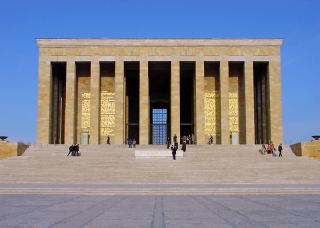 A frontal view of Anitkabir
Photo: Helen P. Betts
Anıtkabir
Anıtkabir (literally, "memorial tomb") is the mausoleum of Mustafa Kemal Atatürk, the leader of the Turkish War of Independence and the founder and first president of the Republic of Turkey. It is located in Ankara and was designed by architects Professor Emin Onat and Assistant Professor Orhan Arda, whose proposal beat 48 other entries from several countries in a competition held by the Turkish Government in 1941 for a "monumental mausoleum" for Atatürk. Anıtkabir Atatürk Museum opened on 21 June 1960. On display are Atatürk's personal items, his wardrobe, and some of the gifts presented to him are on display in this museum. Atatürk's medals, decorations and some personal items donated to the museum by his adopted children are also exhibited in the museum.
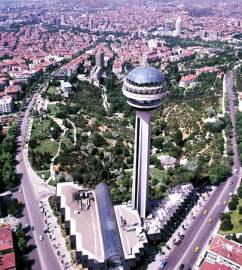 View of Atakule Tower and Ankara's city center
Photo: Ankaralı Turgut
Atakule is a 125m (410 feet) high communications and observation tower located in the Çankaya district of central Ankara, Turkey and is the primary landmark of the city. As the district of Çankaya is itself on a hill, the tower can be spotted from almost anywhere in the city during clear days. The top section of the tower houses an open terrace and a revolving restaurant, which makes a full 360 degree rotation in one hour.
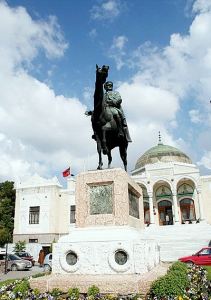 The Ethnography MuseumMuseum of Anatolian Civilizations
The Museum of Anatolian Civilizations is located on the south side of Ankara Castle in the Atpazarı area in Ankara, Turkey. It consists of the old Ottoman Mahmut Paşa bazaar storage building, and the Kurşunlu Han. The museums collection begins with with the Paleolithic era, and continues chronologically through the Neolithic, Early Bronze, Assyrian trading colonies, Hittite, Phrygian, Urartian, Greek, Hellenistic, Roman, Byzantine, Seljuk and Ottoman periods. There is also an extensive collection of artifacts from the excavations at Karain, Çatalhöyük, Hacılar, Canhasan, Beyce Sultan, Alacahöyük, Kültepe, Acemhöyük, Boğazköy (Gordion), Pazarlı, Altıntepe, Adilcevaz and Patnos as well as examples of several periods.
Ethnography Museum of Ankara
The Ethnography Museum of Ankara is a museum of ethnography dedicated to the cultures of historic and current civilizations that flourished in Turkey. The museum hosted the sarcophagus of Mustafa Kemal Atatürk from November 21, 1938 until November 10, 1953, during the period of the construction of Anıtkabir, his final resting place.
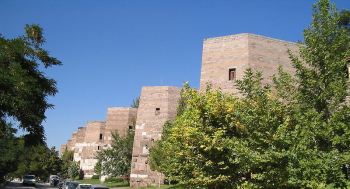 Ankara Castle walls
Photo: Peace01234Ankara Citadel
The foundations of the citadel or castle were laid by the Galatians on a prominent lava outcrop, and the rest was completed by the Romans. The Byzantines and Seljuqs further made restorations and additions. The area around and inside the citadel, being the oldest part of Ankara, contains many fine examples of traditional architecture. There are also recreational areas to relax. Many restored traditional Turkish houses inside the citadel area have found new life as restaurants, serving local cuisine.
Temple of Augustus and Rome
The temple, also known as the Monumentum Ancyranum, was built between 25 BC - 20 BC following the conquest of Central Anatolia by the Roman Empire and the formation of the Roman province of Galatia, with Ancyra (modern Ankara) as its administrative capital. The temple, on the ancient Acropolis of Ancyra, was enlarged by the Romans in the 2nd century. In the 5th century it was converted into a church by the Byzantines. It is located in the Ulus quarter of the city.
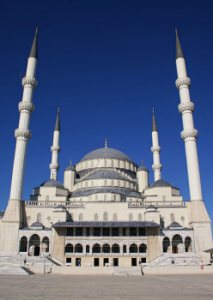 A view of the Kocatepe Mosque
Photo: Noumenon
The Kocatepe Mosque is the largest mosque in Ankara, the capital of Turkey. It was built between 1967 and 1987 in the Kocatepe quarter in Kızılay, and its size and prominent situation have made it a landmark that can be seen from almost anywhere in central Ankara.
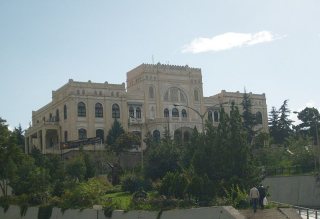 The State Art and Sculpture Museum in Ankara<
Photo:
Cetorhinus
The State Art and Sculpture Museum is a museum dedicated to fine arts and sculpture in Ankara, Turkey. It is located close to the Ethnography Museum and houses a rich collection of Turkish art from the late 19th century to the present day. There are also galleries for guest exhibitions. Exhibitions of painting, sculpture, ceramic, printing arts and photography that are programmed to take place in Turkey within the framework of international cultural agreements, are exhibited in the three galleries reserved for periodical exhibitions. In the historical hall which has been transformed to its original design during the restorations, different kinds of activities such as concerts, theatrical performances and movie projections take place.
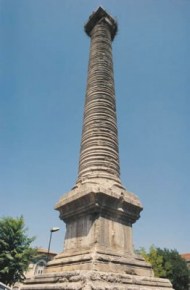 Column of Julian Photo: Kara Sabahat Column of Julian
The Column of Julian or Julianus, now in the Ulus district, was erected in honor of the Roman Emperor Julian the Apostate's visit to Ancyra in 362. Julian the Apostate commonly known as Julian, or also Julian the Philosopher, was Roman Emperor from 355 to 363 and a noted philosopher and Greek writer.
Hatti Monument
Built in the 1970s on Sıhhiye Square, this impressive monument symbolizes the Hatti gods and commemorates Anatolia's earliest known civilization. The symbol derived from this monument has been used as the logo of the city for a long time.
|
|
|
Festivals & Events
Ramadan
People, neighbours, relatives and friends pay visits and go to see each other. Young people kiss their parents’ hands and receive best wishes and blessings from them. It is a tradition to give money or little gifts to those childreen who kiss one’s hands. Candies are served to visitors during Ramadan. That is why Ramadan is also called the “Sugar Festival”.
Feast of the Sacrifice
This festival takes place in Islam as a memory of the story in which a ram fell from the sky just at the moment when the Prophet Abraham was about to sacrifice his son to God.
Hıdrellez
Hıdrellez, is one of the seasonal festivals of all Turkish world. Hıdrellez Day, which is known as Ruz-ı Hızır (day of Hızır), is celebrated as the day on which Prophets Hızır and Ilyas met with each other on earth. The words Hızır and İlyas have since fused together pronounced as Hıdrellez. Hıdrellez Day falls on May 6 in the Gregorian calendar and April 23 in the Julian calendar, also known as the “Rumi” calendar.
Nevruz
The word Nevruz is of Persian origin and is a combination of the words “nev” (new) and “ruz” (day), meaning new day. According to the old Persian calendar, it is the first day of the year and regarded as the start of spring, when the sun enters the house of Aries.
Victory Festival, (August 30)
On this day in 1922, the fifth day of the big attack against the invading Greek Armies, the Dumlupinar Battle under the command of Mustafa Kemal was won and determined the result of the Independence War. This big attack ended in Izmir with the defeat of the Greeks on September 9.
The Republic Festival, October 29
This is the anniversary of the declaration of the Turkish Republic by the Turkish Grand National Assembly in 1923.
National Sovereignty and Children's Day,
April 23
On this date in 1920, during the War of Independence, the Turkish Grand National Assembly was established in Ankara by Mustafa Kemal and laid down the foundations of a new independent state from the ashes of the Ottoman Empire. The founder of the Turkish Republic, Mustafa Kemal Atatürk, dedicated April 23 to the children of the country to emphasize that they are the future of the new nation. This is the world's first and only holiday for children.
Commemoration of Atatürk and Youth and Sports Day,
May 19
On this date in 1919, Mustafa Kemal arrived in Anatolia at the Black Sea Port of Samsun which marks the beginning of the War of Independence. The week including this holiday has been celebrated as "Youth Week" in Turkey since 1983.
Seker Bayrami
This three day festival comes after an entire month of "absolute" fasting during Ramadan in which Qur'an was revealed.
Kurban Bayrami
This four day festival falls on the tenth day of the last month of the Muslim year and marks the completion of the course of Hajj (pilgrimage to Mecca). Sacrificial animals are slaughtered and their meat distributed among relatives, neighbors and the poor on this occasion. The slaughtering of animals is a symbolic expression whereby a Muslim express his readniess to lay down his own life and everything he owes for the sake of God.
|
|
|